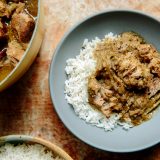Comforting, but heavy. A fitting description for most meaty stews. But as we learned, there are ways to lighten the load. Our search for stews that deliver richness, yet remain light, brought us to the curries of Mangaluru, a port city on the southwest coast of India. It’s the home of dukra maas, a tangy pork curry that provides balance by doubling down on sour flavors.
A Sunday staple in many Mangalorean Catholic homes, dukra maas is a balance of flavors and cultures. Pork slowly simmers in a tangy sauce laden with tamarind, chilies, aromatics and spices, the meat becoming especially tender and flavorful. While eating pork is unusual in many parts of India, it became popular in Mangaluru thanks to the trade routes that brought Portuguese sailors—and their influences—to the region.
This delicious melding is what makes the dish special, says Raghavan Iyer, author of “On the Curry Trail: Chasing the Flavor That Seduced the World.” “It signifies a sense of balance,” he says. “It has finesse.” That finesse comes mainly from the addition of sour ingredients, a balancing act seen in many cuisines, including American barbecue.
In the case of dukra maas, two ingredients in particular give it its trademark tang: tamarind and vinegar. Bafat powder—a fiery Mangalorean spice blend—further enhances the dish with bright chili heat.
A tropical fruit prized for its tangy pulp by cooks all over the world, tamarind forms the foundational flavor of this curry. As a bonus, we also found it to be an effective meat tenderizer. Finishing the dish with a splash of white vinegar highlights those bright notes.
For our version of dukra maas, we start by briefly heating the aromatics and spices in fat, the essential first step of most curries. This deepens their flavors and seasons the oil for more even spicing. Pork shoulder then is added—and with this much flavor, there’s no need to sear it—along with broth and strained tamarind pulp.
After that, the cooking mostly is hands-off. Three hours in the oven produces pork that is fall-apart tender, a result helped along by the tenderizing effect of the tamarind.
We did need to find a substitute for the hard-to-source bafat powder. But with Iyer’s encouragement, we found that this was easily done. “The beauty of a curry is everything goes,” he explains. Though blends vary, bafat is distinguished by intense citrusy, earthy and bright flavors. We settled on a mix of coriander, cumin, curry powder, fennel and black pepper. For heat, we rely on fresh jalapeños and the zing of fresh ginger.
Deeply savory and mouthwateringly tangy, the finished dish is comfort food at its finest—made better by being brighter.







